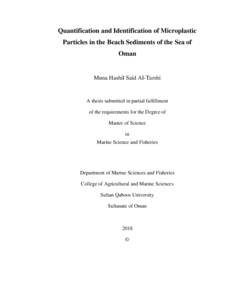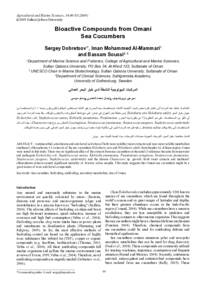Document
Quantification and identification of microplastic particles in the beach sediments of the sea of Oman
Publisher
Sultan Qaboos University
Gregorian
2018
Language
English
Subject
English abstract
Plastics and particularly microplastics are entering our oceans at an increasing rate. These microparticles enter food chains, disrupt reproductive cycles and are ingested by marine animals as mistaken food. A few studies on Oman beaches documented a dominance of plastic debris, but the occurrence of microplastics on the Sultanate beaches remains undocumented. Thus, the foremost objectives of this study were to evaluate the scale of the microplastic problem in the region and locally and to develop indicators to assess the prevalence of microplastic in the marine environment. This study reports for the first time, the presence, concentration, type and size of microplastics in Oman beach environment. It also proposes a standard and inexpensive protocol for the sampling, extraction and analysis of microplastics from sediment of the coastal areas. Biological and organic matters were removed from the sediment in a pre-treatment using sodium hypochlorite. Microplastics were then separated from the sediment by floatation using a saturated NaCl solution. Microplastic particles were then counted and sized on samples collected from 8 beaches spanning 200 km of coastline.Synthetic polymers were identified using (FT-IR) spectrometry.Microplastic particles were detected in all 8 beaches and subdivided into three categories: fragments, pellets and fibers. In term of numbers the most contaminated area was Barka with an average concentration of 50±14.1 particles/kg of sediment) while in term of weight, Al-Qurum was the most polluted area with average weight of 3.7±1.6 g/kg of sediment. The most abundant polymers were polyethylene and polypropylene, in particular in the form of industrial pellets. The presence of microplastics in sediments appear related to on-going disposal practice from beach users, industries and recreational activities along with accidental or intentional discharge from ships, particularly near industrial harbors (Sohar and Qurum). This beach-focused study should be extended geographically to include marine protected area (MPAs), industrial estates such as Raysut, Sohar, Al-Duqum, islands such as Al-Halanyyat and Masirah. In terms of ecosystem, it should be extended (with appropriate changes in methodology) to the surface of the sea. In addition, investigation of microplastics particles could be extended to cover risks of contamination of human consumed marine organisms.
Member of
Resource URL
Arabic abstract
يتزايد وجود مخلفات البلاستيك وخصوصا الجسيمات البلاستيكية الدقيقة في المحيطات بشكل متسارع , الأمر الذي يؤثر سلبا على السلاسل الغذائية و على تكاثر الكائنات البحرية عندما تقوم بإلتهام هذه الجسيمات البلاستيكية كطعام , الأمر الذي يؤدي إلى انسداد مجرى الأمعاء في جهازها الهضمي ومع أن بعض الدراسات قد أثبتت وجود تراكم إنتشار المخلفات البلاستيكية في الشواطئ العمانية إلا أنه لم يتم اثبات وجود الجسيمات البلاستيكة الدقيقة لذلك فإن الأهداف الرئيسية لهذه الدراسة هي : تقييم حجم مشكلة وجود وتراكم الجسيمات البلاستيكية الدقيقة في المنطقة و سد فجوة عدم توفر البيانات الخاصة بهذا المجال, وايجاد مؤشرات التقييم دور المؤسسات البيئية وذات العالقة للمحافظة على سلامة ونظافة البيئة البحرية. وكذلك إتاحة المجال لمراقبة البيئة البحرية من الجسيمات البلاستيكية الدقيقة تقوم هذه الدراسة ولأول مرة بإثبات وجود وتركيز وانواع وكميات الجسيمات البلاستيكية الدقيقة في سواحل سلطنة عمان المطلة على بحر عمان. كما تقوم هذه الدراسة بإقتراح بروتوكول قياسي و غير مكلف لأخذ العينات, واستخلاص وتحليل الجسيمات البلاستيكية الدقيقة في رواسب الشواطئ العمانية . تم التخلص من المركبات العضوية والحيوية وفصلها عن الرواسب باستخدام هيبوكلورات الصوديوم. ثم تم فصل الجسيمات البلاستيكية الدقيقة من الرواسب بإستخدام محلول مشبع من ملح كلوريد الصوديوم. وتم بعد ذلك حساب عدد الجسيمات البلاستيكية الدقيقة وقياس حجمها من تمان عينات تم جمعها من تمان شواطئ مختلفة مطلة على بحر عمان. وتم التعرف على انواع البليمرات بإستخدام جهاز مطياف الأشعة تحت الحمراء، وقد تم اثبات وجود الجسيمات البلاستيكية الدقيقة في المواقع التمانية المختارة. حيت تم تقسيم الجسيمات البلاستيكية الدقيقة الى ثلاثة أقسام (جسيمات و كريات والياف), وقد وجد أن ولاية بركاء الأكثر تلونا من حيث العدد بمعدل (50= 14 .
142 وحدة (كجم) وكانت القرم هي الأكثر تلونا من حيت الكتلة بمعدل ( 3 . 691= 1 . 570 جم/كجم). وقد كشف جهاز مطياف الأشعة تحت الحمراء بأن البولي إيثيلين هو الأكثر انتشارا في المنطقة ويليه البولي بروبيلين. ويعزى سبب وجود الجسيمات البلستيكية الدقيقة في المنطقة إلى الممارسات الخاطئة لدى مستخدمي الشواطئ وكذلك الى الأنشطة الصناعية و الترفيهية هذا إلى جانب انشطة السفن المختلفة وخصوصا بالقرب من الموانئ الصناعية (صحار والقرم) ولهذا السيب , فإنه يقترح توسيع دراسة الكشف عن تراكيز الجسيمات البلاستيكية الدقيقة لتشمل سطح البحر ومناطق المحميات البحرية (المانجروف والديمانيات والمدن الصناعية مثل (ريسوت وصحار والدقم) وكذلك الجزر مثل (الحوتيات ومصيرة) كما يجب الكشف عن الجسيمات البلاستيكية الدقيقة في الأغذية بما فيها الأسماك المستهلكة محليا وبعض الحيوانات البحرية كالأصداف و القواقع و غيرها.
142 وحدة (كجم) وكانت القرم هي الأكثر تلونا من حيت الكتلة بمعدل ( 3 . 691= 1 . 570 جم/كجم). وقد كشف جهاز مطياف الأشعة تحت الحمراء بأن البولي إيثيلين هو الأكثر انتشارا في المنطقة ويليه البولي بروبيلين. ويعزى سبب وجود الجسيمات البلستيكية الدقيقة في المنطقة إلى الممارسات الخاطئة لدى مستخدمي الشواطئ وكذلك الى الأنشطة الصناعية و الترفيهية هذا إلى جانب انشطة السفن المختلفة وخصوصا بالقرب من الموانئ الصناعية (صحار والقرم) ولهذا السيب , فإنه يقترح توسيع دراسة الكشف عن تراكيز الجسيمات البلاستيكية الدقيقة لتشمل سطح البحر ومناطق المحميات البحرية (المانجروف والديمانيات والمدن الصناعية مثل (ريسوت وصحار والدقم) وكذلك الجزر مثل (الحوتيات ومصيرة) كما يجب الكشف عن الجسيمات البلاستيكية الدقيقة في الأغذية بما فيها الأسماك المستهلكة محليا وبعض الحيوانات البحرية كالأصداف و القواقع و غيرها.
Category
Theses and Dissertations


